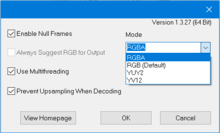Lagarith

Lagarith 1327 configuration dialog running on Windows 10.
Lagarith is an open source lossless video codec written by Ben Greenwood.[1] It is a fork of the code of HuffYUV and offers better compression at the cost of greatly reduced speed on uniprocessor systems.[2][3] Lagarith was designed and written with a few aims in mind:
- Speed
- while not as fast as HuffYUV, it still outperforms most other lossless video codecs when it comes to encoding times,[4][5] although decoding speed may be slower. Recent versions also support parallelizing on multi-processor systems.
- Color-space support
- color-space conversions can cause rounding errors, introducing data loss, contrary to the ideal of lossless video compression. Lagarith attempts to avoid this problem by supporting YV12, YUY2, RGB, and RGBA colorspaces.
- Keyframes
- disallowing inter-prediction means that each frame can be separately decoded. This makes cutting, joining and seeking much easier.
These three things, as well as being more efficient at compression than HuffYUV, make it a codec useful for the video editing stage.
External links
References
- ↑ Biebeler, Ralf (2007). Video-Codecs. p. 60. ISBN 978-3-7949-0773-1.
- ↑ Lagarith Lossless Video Codec. Retrieved 2009-01-28
- ↑ the case against Lagarith. Retrieved 2013-06-26
- ↑ "Lossless Video Codecs Comparison 2007".
- ↑ "Design and Performance Evaluation of some Conditional Replenishment Schemes for Video".
This article is issued from
Wikipedia.
The text is licensed under Creative Commons - Attribution - Sharealike.
Additional terms may apply for the media files.